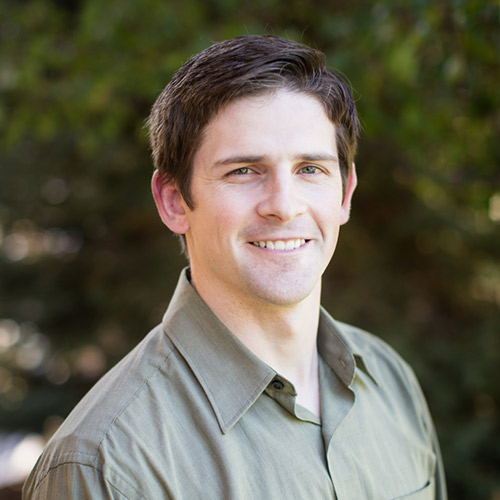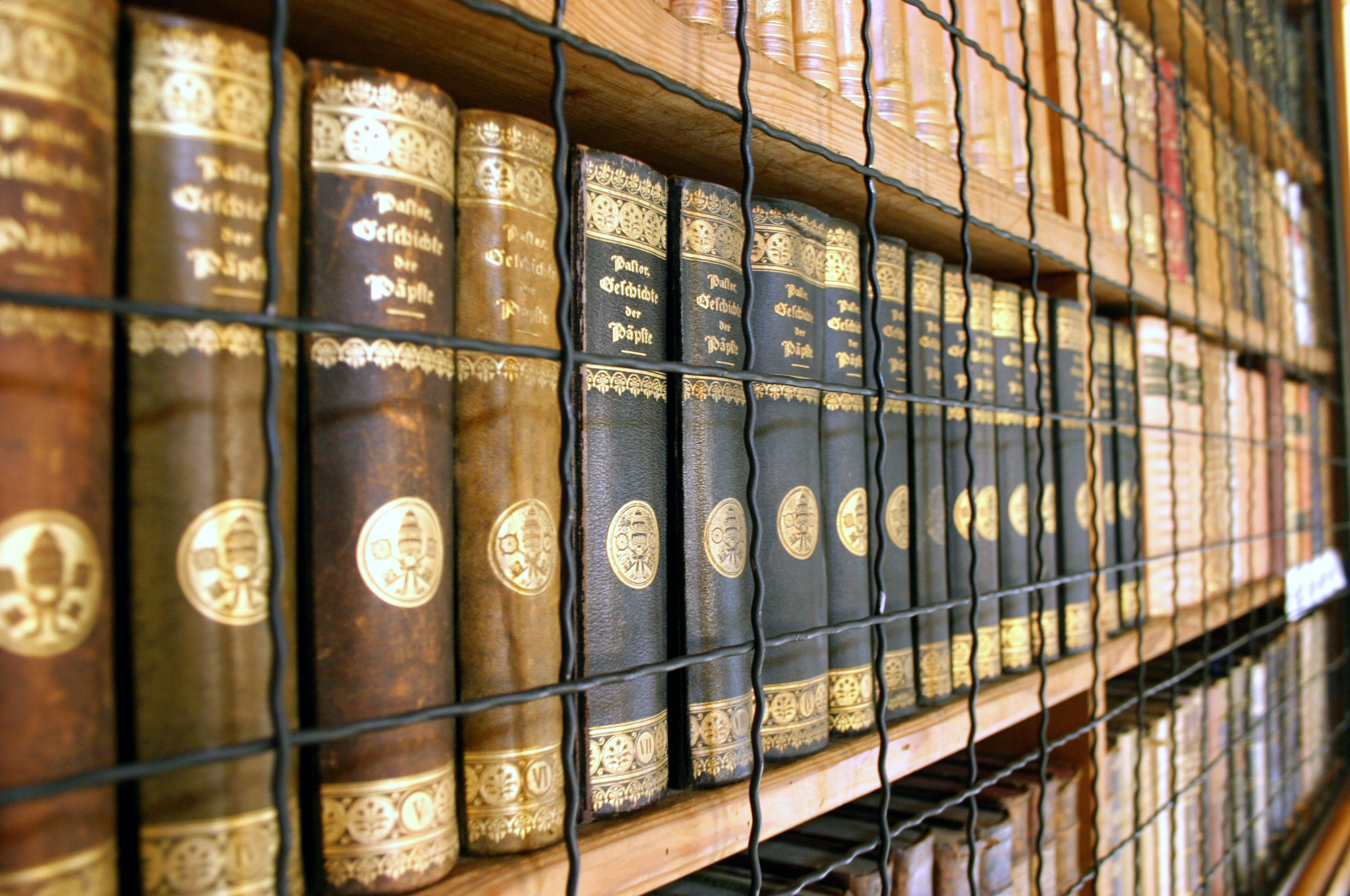NSBA Networking Event
Our own Dallin Call and will be attending the Nebraska State Bar Association (NSBA) networking event. Each year the NSBA hosts an annual NSBA Sections Networking Events at Creighton Law and NU Law. These events are an opportunity for students to talk individually or in small groups with lawyers representing various practice areas. NSBA uses a speed-dating approach so students rotate to different conversations every few minutes to give them exposure to areas or groups they might not otherwise encounter. Both events start at 4 pm and the structured portion of the event lasts about an hour, after which there is an informal social with appetizers/snacks. Dallin Call will be at the Creighton portion of the event on March 1st.
Suiter Swantz IP Team Spotlight: Patrice Sokolowski
Patrice is a farm girl from Iowa who made her way to Omaha to attend Creighton University where she earned a B.S. in Elementary and Special Education. She taught special education for Omaha Public Schools for a number of years.
Patrice has had a life-long love of music. She has performed with Opera Omaha Chorus as well as in musical theatre productions around the Omaha area. Her love of music led her to move to Connecticut where she earned a Master's Degree in Vocal Performance from the University of Connecticut. From there, Patrice moved to New York City for additional studies, performance opportunities, and to partake in the vast musical scene that the Big Apple has to offer. While in New York, she enjoyed working for a large global financial bank.
Her next move brought her back to Omaha—full circle you could say. She likes being back in the heart of the agricultural belt and is happy to be part of the Suiter Swantz IP law firm. When asked what she likes best about patent and trademark law, she said it is exciting and gratifying to work in an organization that helps clients protect new ideas, trade secrets, and innovation.
Outside the office, Patrice has served on the boards of several nonprofit musical theater and similar organizations. She keeps up with her singing and loves choral music. Patrice recently traveled to Rome, by invitation, with St. Cecilia Cathedral Choir to sing at the Pontifical Mass closing the Jubilee Year of Mercy.
Patent of the Day: Milking Machine
Suiter Swantz IP takes a look back at past inventions and inventors with our Patent Of The Day.
On this day in 1920, Ralph L. Hinmam was granted U.S. Patent No. 1,330,872 for a MILKING MACHINE.
This invention relates to certain improvements in milking machines, and pertains particularly to a milking machine of the valve chamber type in which each valve chamber is preferably suitably connected to a small-diameter, long-stroke piston pump for producing vacuum in the chamber and to suitable teat cups into which the milk is drawn by vacuum produced in the valve chamber and the connecting hose by said pump.
It has been usual to provide the valve chamber with a suitable inlet for milk and an exhaust for air, both preferably positioned adjacent the upper end of the chamber and penetrating the wall of the chamber itself, and with a valve outlet for the milk at the lower end of the chamber, the valve being movable to open and close said outlet all as shown in reissued Letters Patent No. 18,876, granted to Arthur V. Hinman and Ralph L. Hinman under date of February 9, 1915.
The primary object of the invention here is the production of a milking machine of the-valve chamber type which shall be easily cleaned and kept clean, the parts of which are readily accessible and which shall be efficient in the operation of milking, and the structure illustrated as exemplary of this invention operate in a manner distinctly different from that of the reissued patent above-referred to, in that the valve chamber itself is movable under the combined action of gravity and suction toward and from a stationary valve which renders the chamber substantially air tight, except for the communicating passages above-referred to.
Suiter Swantz IP is a full-service intellectual property law firm serving all of Nebraska, Iowa and South Dakota. If you have any intellectual property questions or need assistance with any patent, trademark or copyright matters and would like to speak to one of our patent attorneys please feel free to contact us.
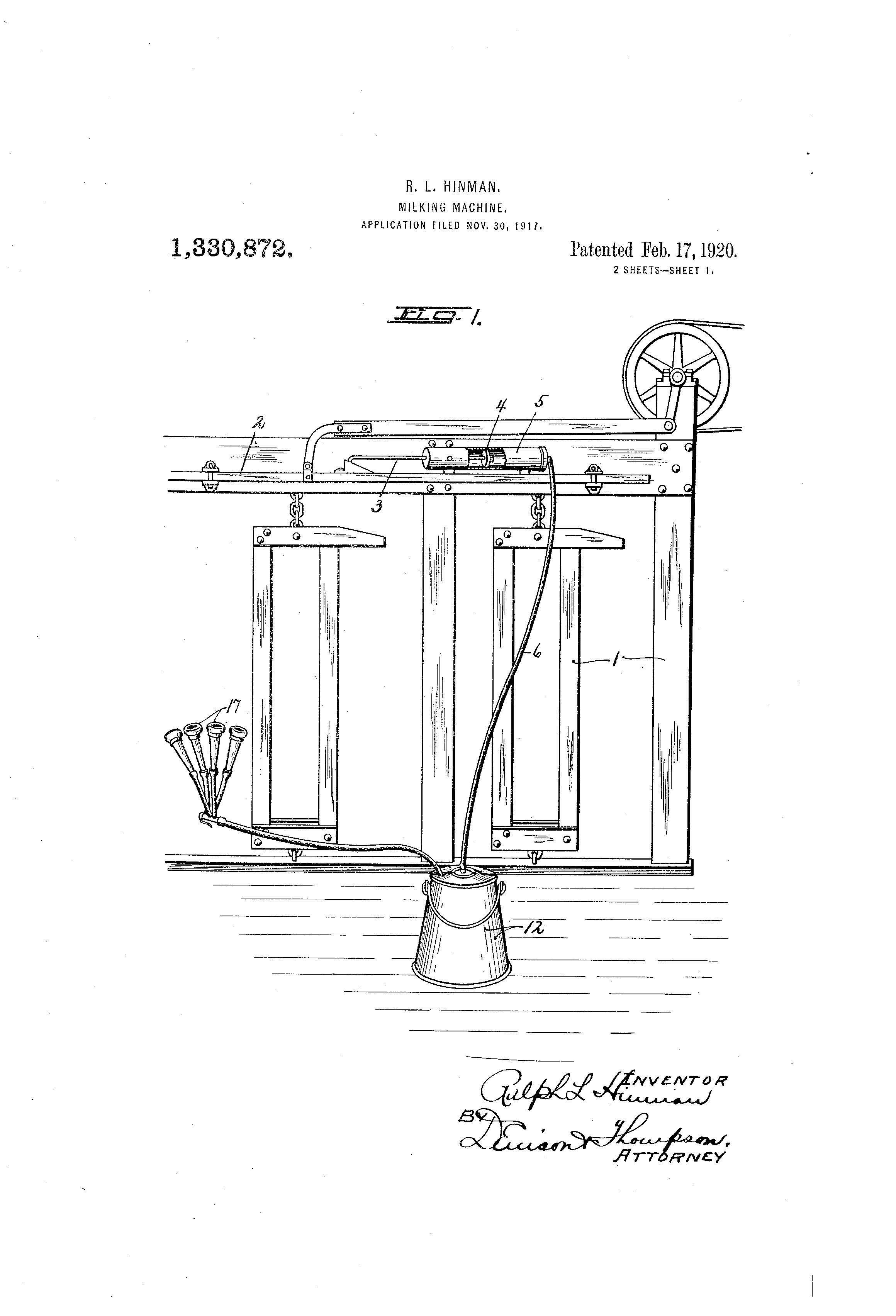
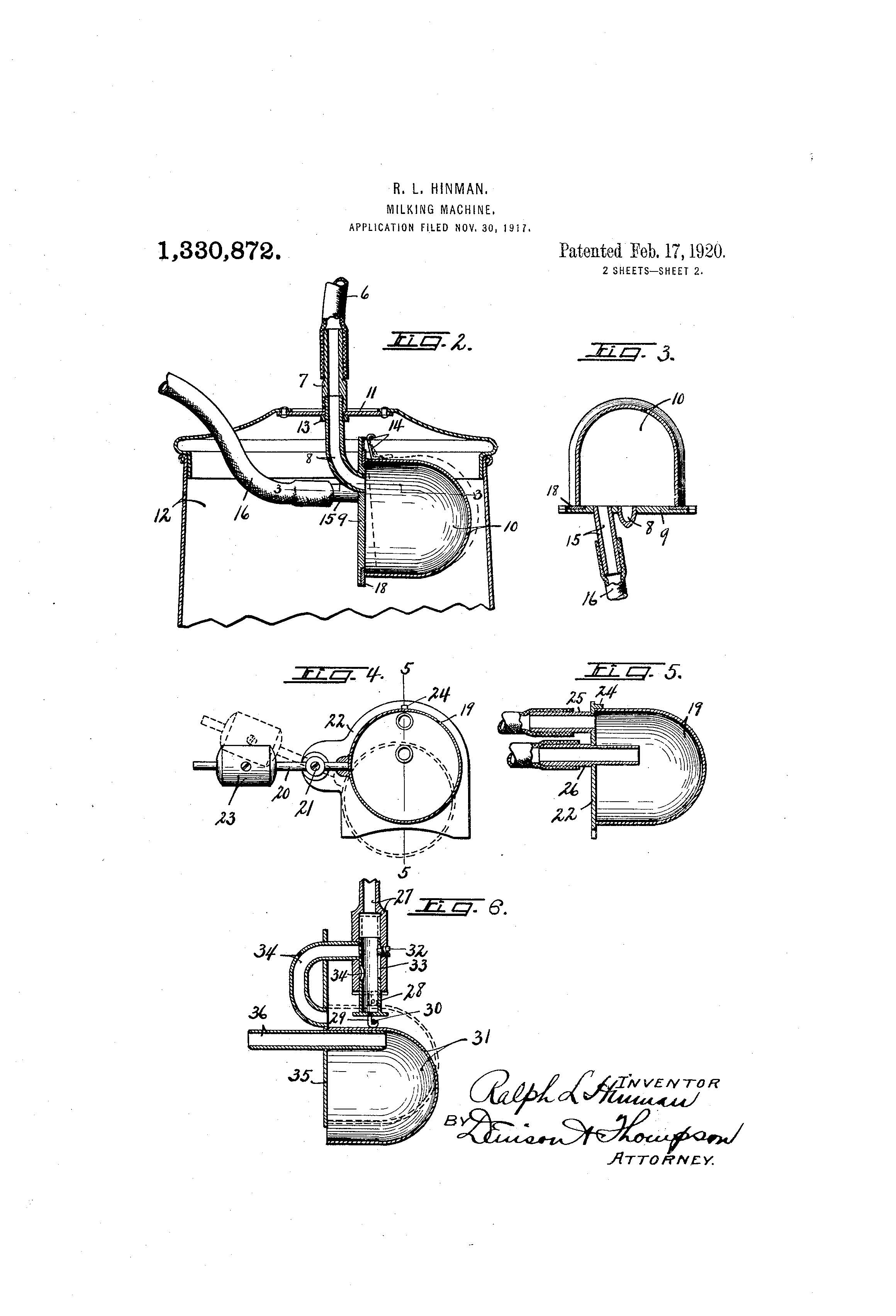
Patent of the Day: Repeating Alarm Clock
Suiter Swantz IP takes a look back at past inventions and inventors with our Patent Of The Day.
On this day in 1904, William Fletcher was granted U.S. Patent No. 752,319 for a REPEATING ALARM CLOCK. .
This invention relates to certain improvements in alarm-clocks, and especially to that class of clocks in which the alarm is sounded intermittently, as distinguished from the ordinary alarm mechanism, where the gong is sounded continuously until the spring has been fully unwound.
The principal object of the invention is to provide a novel form of mechanism for governing the operation of the clapper-rod and to provide a simple and inexpensive mechanism by means of which the intermittent movement may be governed by the ordinary clock mechanism.
A further object of the invention is to provide a means for regulating the intermittent movement of the clapper, so that the intervals of ringing will be uniform.
Suiter Swantz IP is a full-service intellectual property law firm serving all of Nebraska, Iowa and South Dakota. If you have any intellectual property questions or need assistance with any patent, trademark or copyright matters and would like to speak to one of our patent attorneys please feel free to contact us.
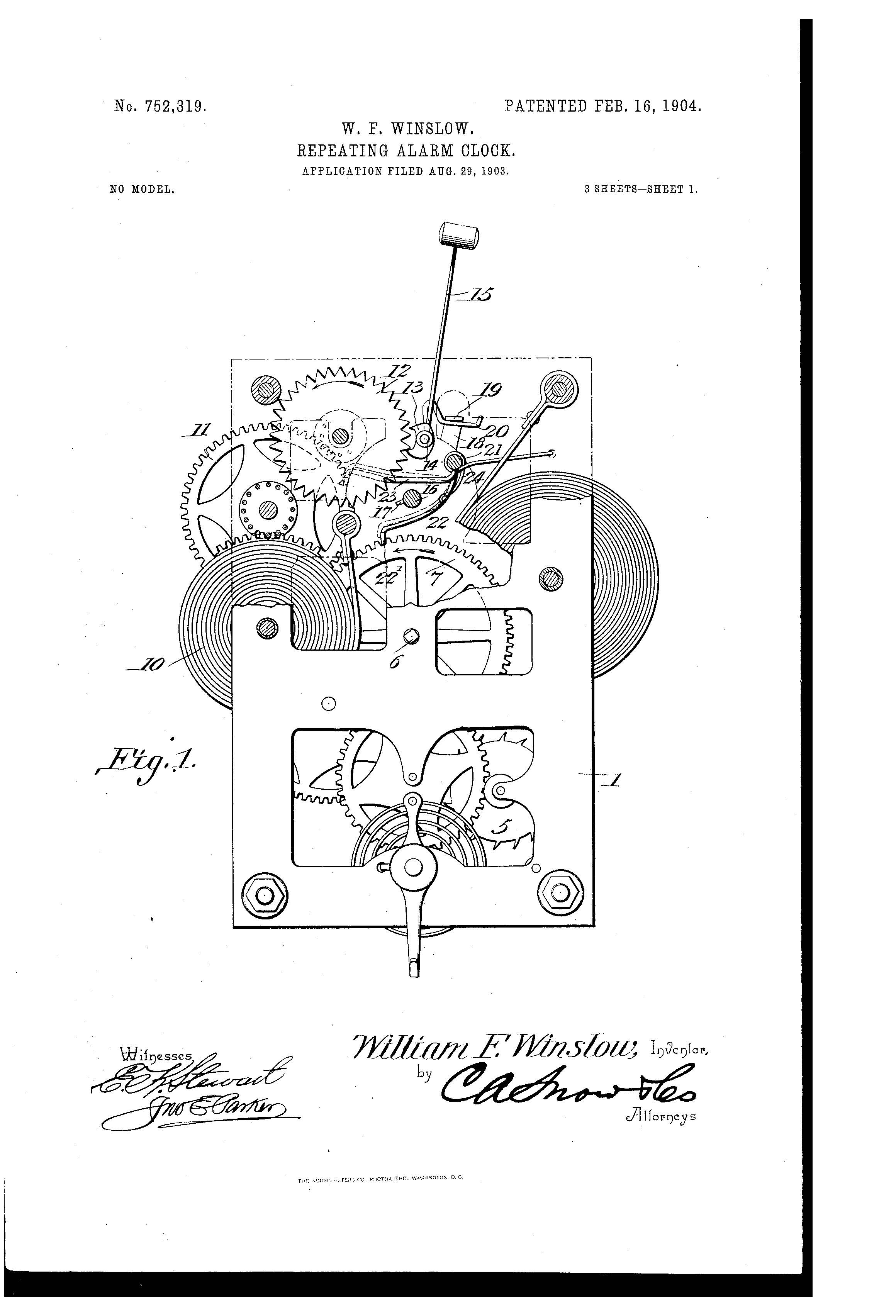
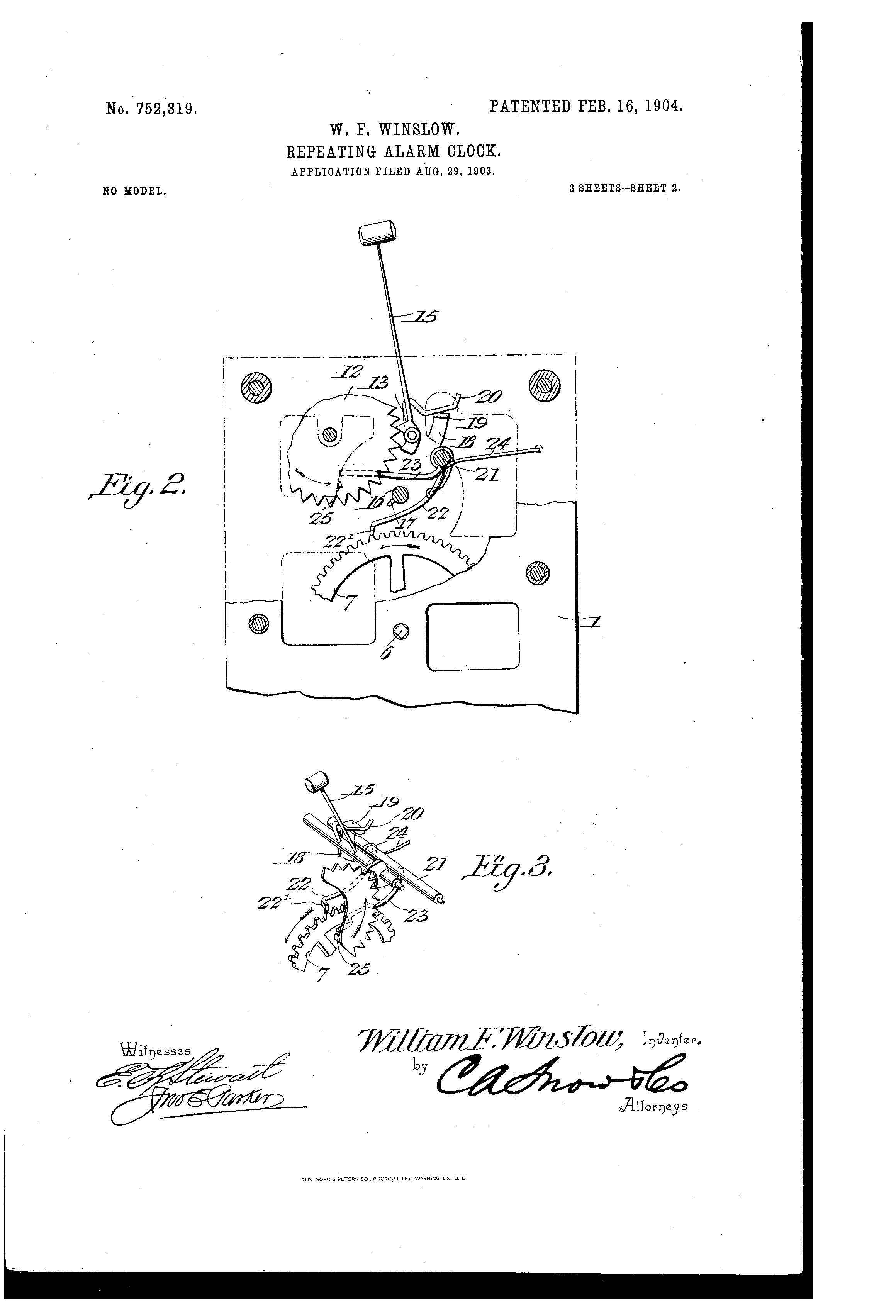
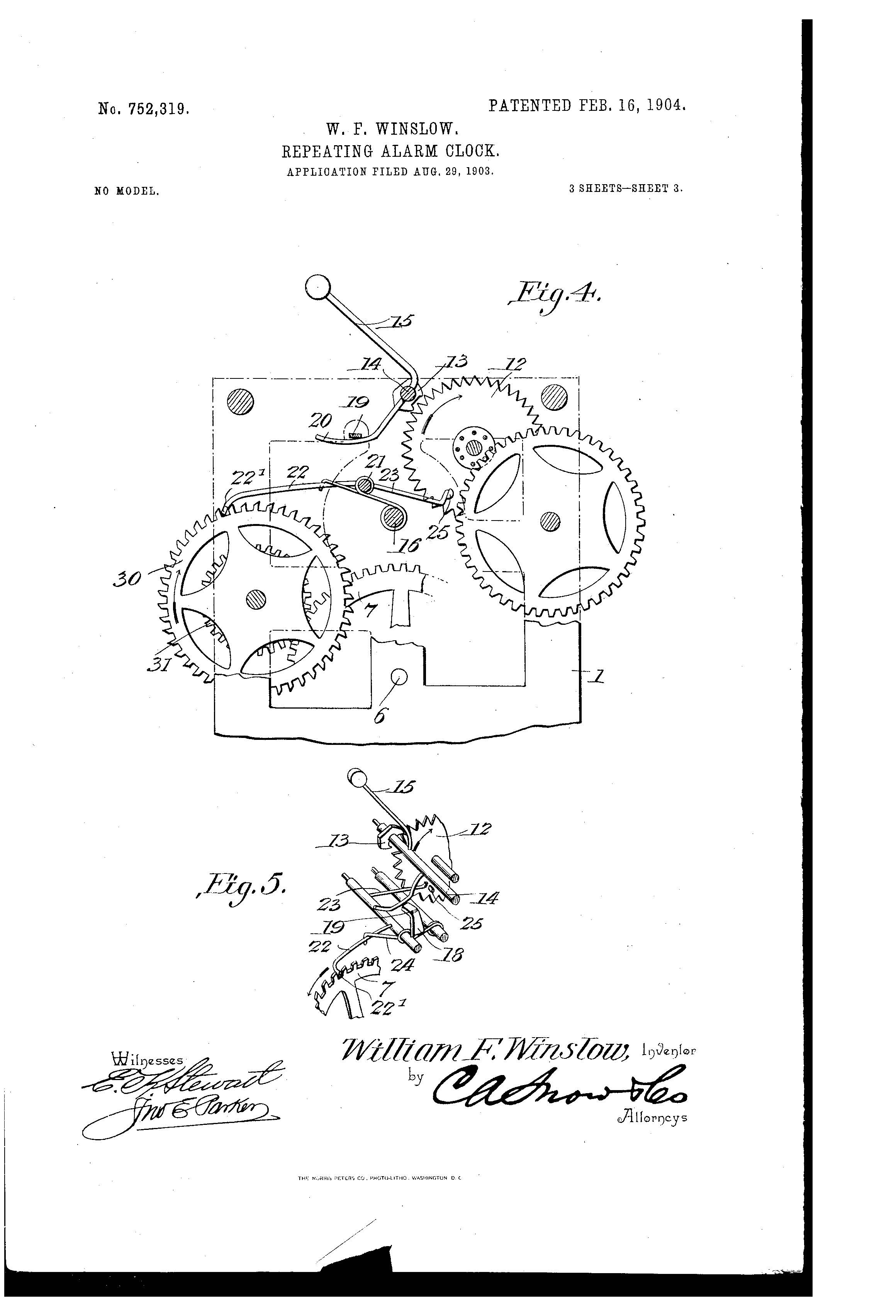
Ancestry.com Pays $12.5M in Patent Dispute Settlement

Ancestry.com, a genealogy website, and its contract manufacturer Spectrum Solutions, have agreed to pay $12.5 million to OraSure Technologies Inc., and its Canadian subsidiary DNA Genotek, Inc., for infringement of two patents that involve DNA testing technology procedures (U.S. Patent Nos. 8,221,381 B2 and 9,207,164 B2).
Genotek offers biological sample collection products, specifically kits for collecting DNA samples. From 2012 to 2013, Ancestry.com purchased Genotek’s DNA saliva test kits so their customers could use the technology to enhance their genealogical mapping with the ability to trace their ethnic background. In 2013, Ancestry filed a patent application (WO 2015017701 A1) for an improved version of Genotek’s DNA saliva test kit without the permission of Genotek.
In May of 2015 Genotek sued Ancestry and alleged they stole the technology for its own use which violated the terms of the use agreement between the two companies. Ancestry argued that the infringement case should be dismissed because Genotek failed to sufficiently prove patent infringement. The court agreed there was a lack of sufficient evidence until it was pointed out that the DNA kits purchased by Ancestry were labeled as patent-protected and Dr. Chahine, patent attorney and general manager for Ancestry, approved the labels. It was also noted that Dr. Chahine was the first-named inventor on the patent application Ancestry filed.
According to the statement released by OraSure, “[u]nder a Settlement and License Agreement executed by the parties, Ancestry has agreed to pay DNA Genotek a settlement fee of $12.5 million. In addition, DNA Genotek has granted Ancestry a royalty-bearing, non-exclusive, worldwide license to certain patents and patent applications related to the collection of DNA in human saliva. The license granted to Ancestry is limited to saliva DNA collection kits sold or used as part of Ancestry’s genetic testing service offerings and does not cover the sale or use of product outside of Ancestry’s business. The Settlement and License Agreement also provides DNA Genotek with a royalty-free, non-exclusive license to patents related to Ancestry’s existing saliva DNA collection kit and certain modifications thereto.”
The statement went on further to say, “[t]he parties have each agreed to a mutual release of claims and other provisions typical for settlement agreements of this type. The Agreement provides for the dismissal of pending federal lawsuits in the District of Delaware and the Southern District of California and for the parties to jointly seek termination of Inter Partes Review proceedings before the U.S. Patent and Trademark Office involving the DNA Genotek patents asserted in the litigation.”
Douglas A. Michels, President and CEO of OraSure, commented on the settlement and stated, “[w]e are pleased to have resolved this litigation. We are committed to innovation and the creation of new products and solutions for customers in the markets that we serve. An important part of this commitment is the protection of our technology and products and we will remain vigilant in seeking to enforce our intellectual property rights where needed.”
Brandon Borrman, spokesman for Ancestry, also stated, "[w]e are pleased to have this matter resolved and remain focused on delivering our millions of customers the best possible product and experience."
Suiter Swantz IP is a full-service intellectual property law firm serving all of Nebraska, Iowa and South Dakota. If you have any intellectual property questions or need assistance with any patent, trademark or copyright matters and would like to speak to one of our patent attorneys please feel free to contact us.
Patent of the Day: Method of Molding Teflon
On this day in 1966 David C. Trimble was granted the patent for METHOD OF MOLDING TEFLON. U.S. Patent No. 3,235,636.
It is an object of the present invention to develop a novel method for obtaining molded products from halogenated hydrocarbon polymers containing fluorine as the predominating halogen.
Another object is to develop a method for making products having thick sections of polytetrafluoroethylene.
A further object is to make polytetrafluoroethylene objects which can be non-uniform in thickness and which can be of any desired configuration.
An additional object is to devise an improved slurry technique for molding polytetrafluoroethylene and other halogenated hydrocarbon polymers containing fluorine as the predominating halogen.
Still further objects and the entire scope of applicability of the present invention will become apparent from the detailed description given hereinafter; it should be understood, however, that the detailed description and specific examples, while indicating preferred embodiments of the invention, are given by way of illustration only, since various changes and modifications within the spirit and scope of the invention will become apparent to those skilled in the art from this detailed description.
It has now been found that these objects can be attained by vacuum molding polytetrafluoroethylene from a slurry of the same utilizing a mold of the desired configuration. The molded product is then sintered at a temperature of above 327° C., e.g., 350° C., 380° C. or 400° C. Usually, the sintering temperature does not exceed 500° C.
In place of vacuum molding the polytetrafluoroethylene from the slurry alternatively there can be imparted a pressure to the slurry in order to mold the polymer and then sintering is carried out as set forth.
It has been found possible, according to the invention, to build up sections of polytetrafluoroethylene as thick as 100 mils, 1 inch ( 1000 mils), or more, using the invention without getting mud cracking or other undesirable properties nor is there a need to resort to multiple dips with sintering after each dip. Special areas can have a build up of extra amounts of polytetrafluoroethylene either by controlling the level of the slurry, e.g., tilting the mold with the mixture in it or by applying a greater vacuum to the special areas than in other areas or otherwise exposing some areas to a greater concentration of polymer than other areas.
The molded product is not fully cohered prior to sintering and is porous in nature. Consequently, it normally shrinks, e.g., to about 75% of its original size in the sintering operation. While polytetrafluoroethylene has a density of 2.2, the products of the present invention, utilizing polytetrafluoroethylene, have an apparent density of 1.5 to 2.0 without pressuring, while, with compacting, it can be configured to shape at its full density of 2.2.
While normally there is employed a slurry of 0.1—15% of polytetrafluoroethylene in kerosene or varnish makers and painters naphtha, there can be employed other liquid dlspersants inert to and capable of wetting polytetrafluoroethylene and which boil below 327° C., e.g., hexane, nheptane, tetrachloroethylene, pinene ethyl alcohol, acetone isopropyl alcohol, methyl alcohol, diethyl ether, ethylacetate, dibutyl phthalate, triethanolamine, etc.
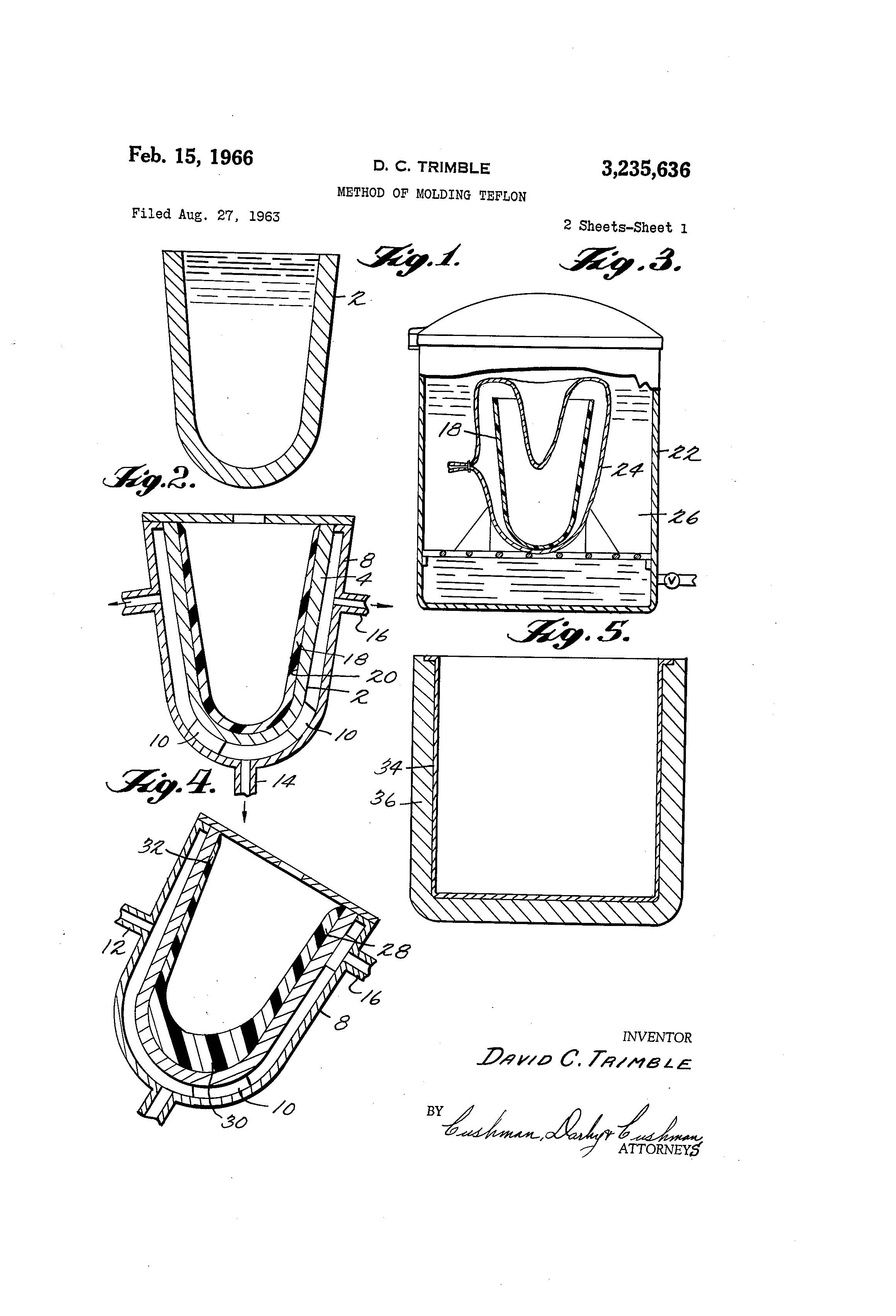
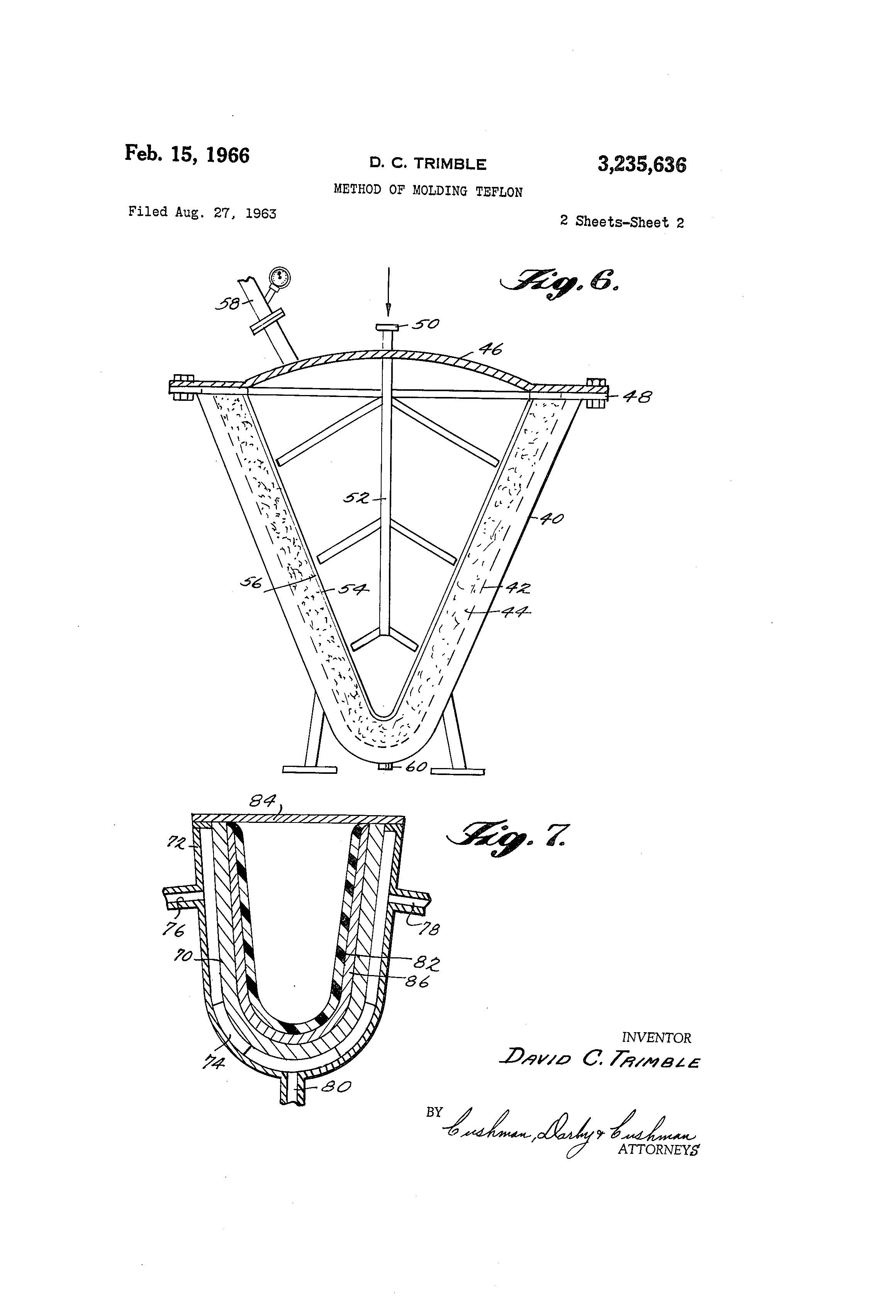
Valentine's Patent of the Day: Love Box
On this day in 1980 Dale A. Ledman and George Spector were granted the patent for LOVE BOX. U.S. Patent No. 4,194,629.
This patent is a box used as a token between lovers for assuring their love to each other; the love box includes an instruction sheet that states the box is filled with love, and not matter how often it is opened, it can never be emptied; and to get a little love, the box should be opened for a short time, while to receive all the person's love it should be left open all the time; the box includes and case and removable cover as well.
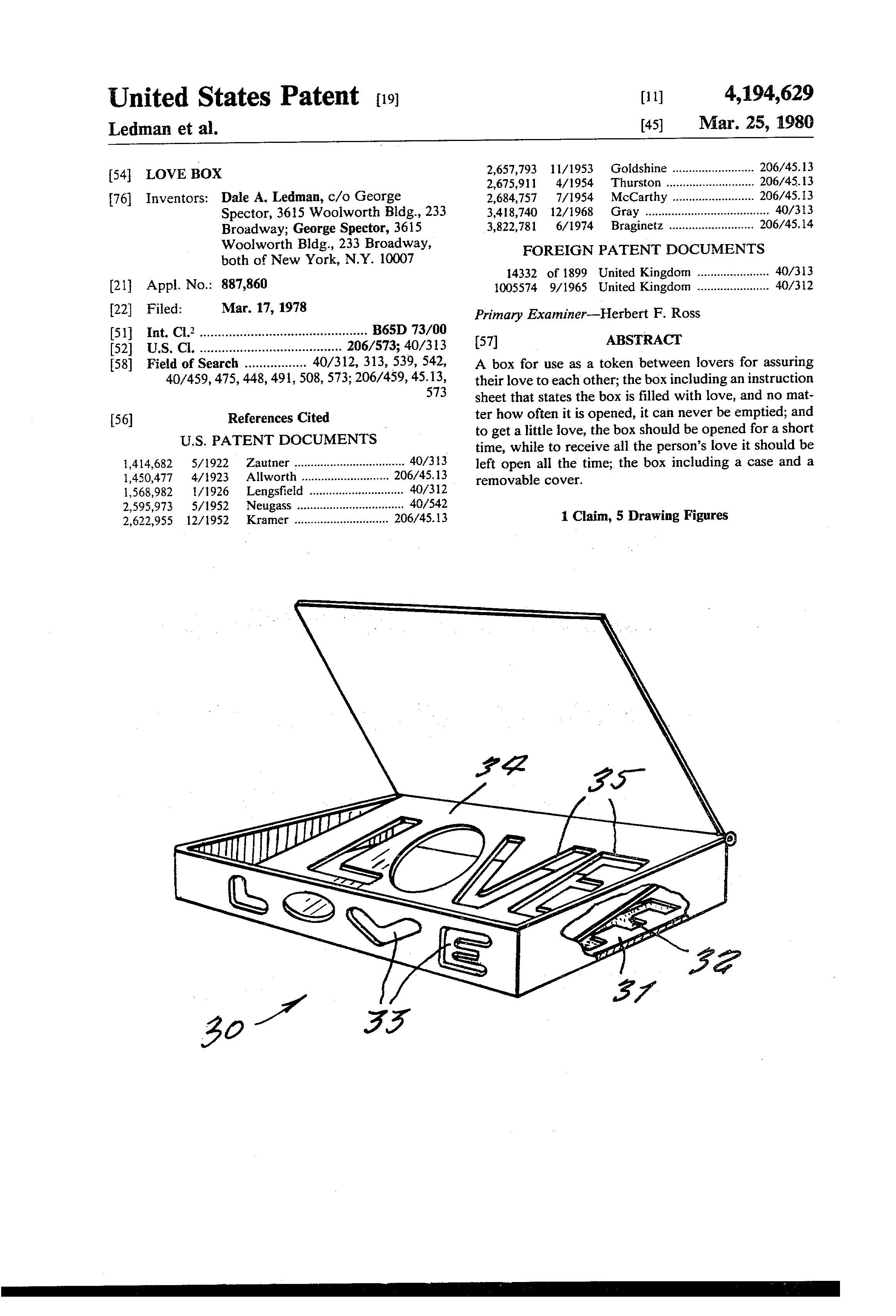
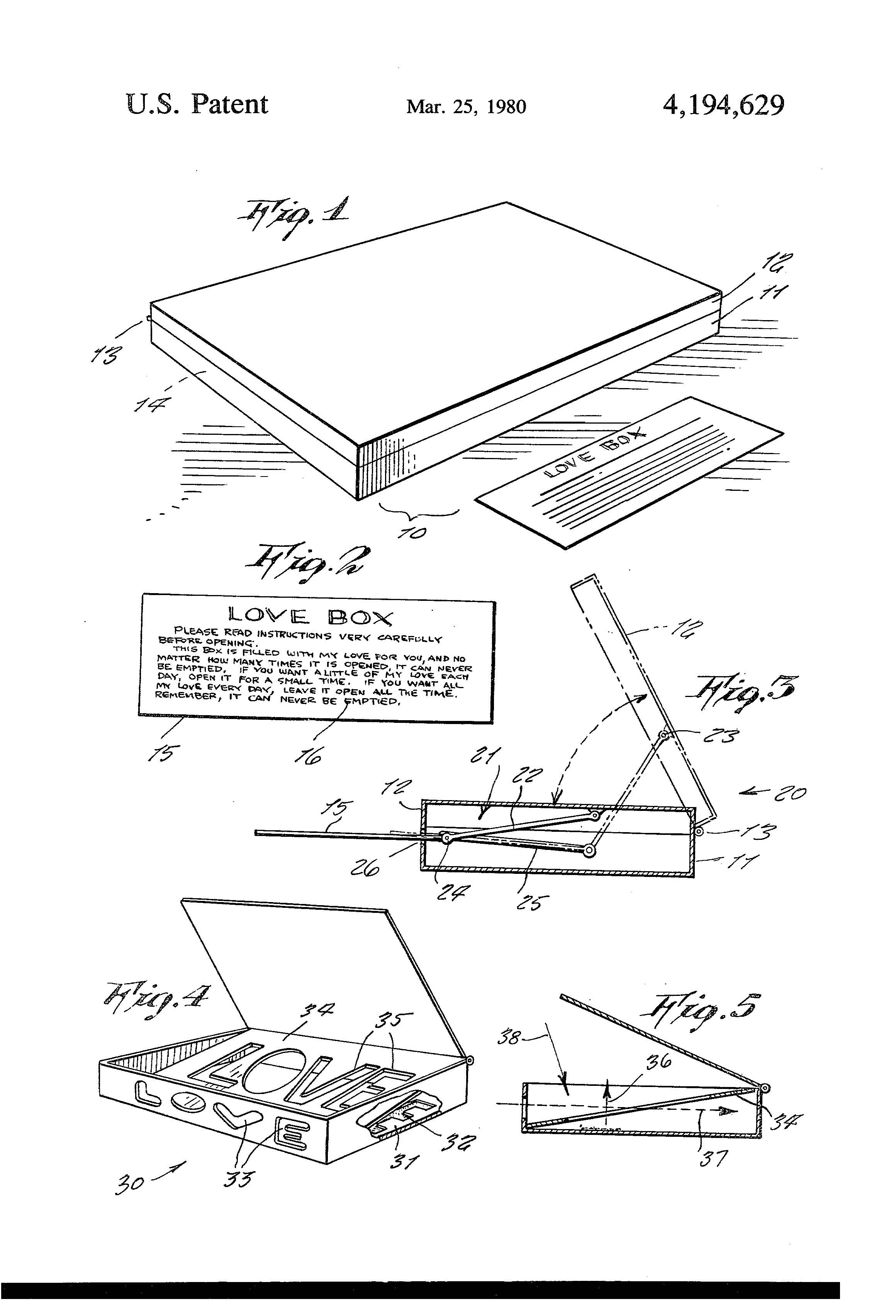
Valentine’s Day and Intellectual Property

Valentine’s Day is here again and, in case you missed the endless aisles of heart-shaped boxes, stuffed animals and flower ads, you should know that it is big business. Valentine’s Day is one of the top grossing holidays. The average person spends about $136.57/year, which when aggregated comes to about $18.6 billion nationally. On average, 90% of the population will ask for chocolates; jewelry purchases will gross about $4.3 billion¹.
Whether you are a person who embraces the holiday or avoids it, we can all get some enjoyment from the various intellectual property that protects some of the products associated with the day.
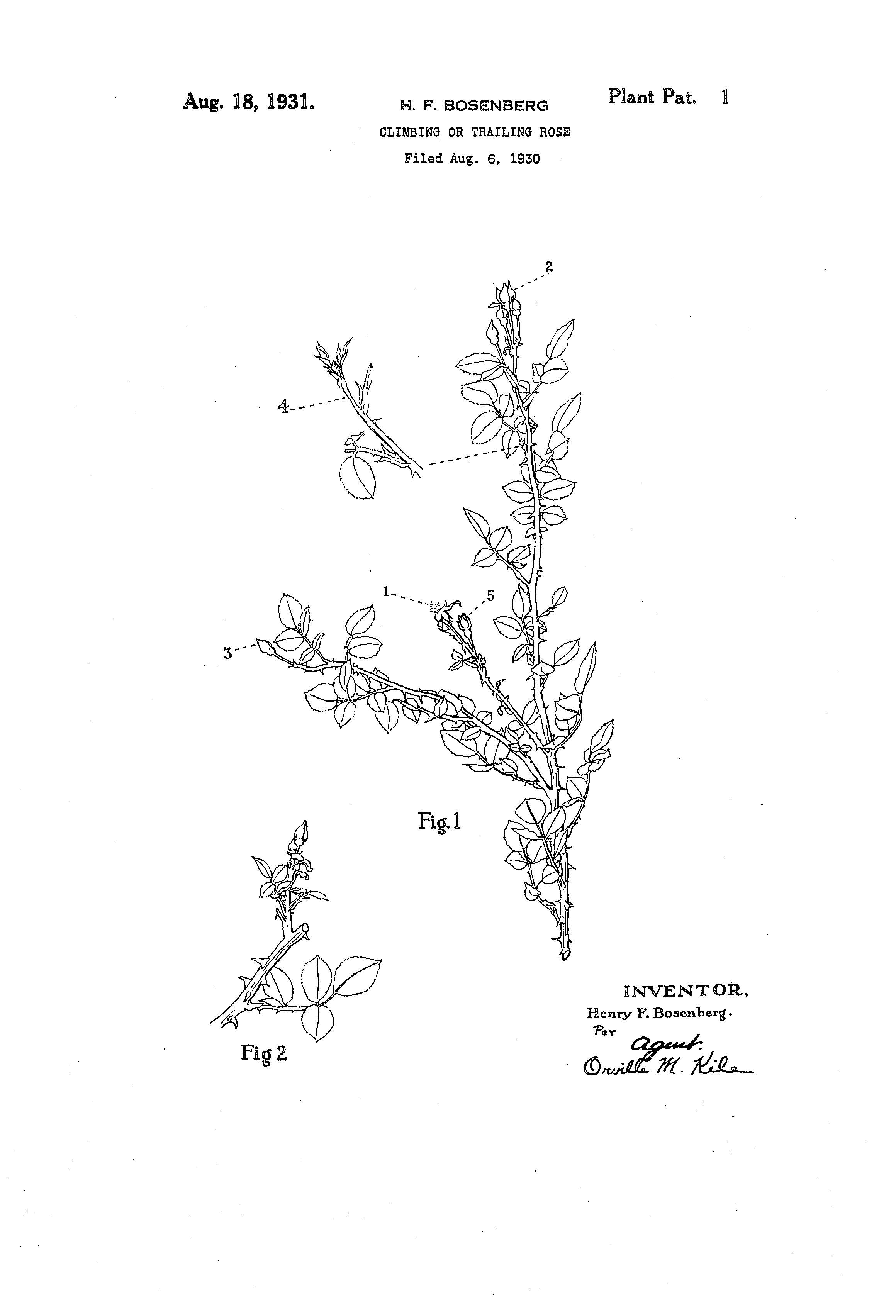 One interesting fact is that roses account for over 4% of issued plant patents. The first patent for a rose was the CLIMBING ROSE (U.S. PP1) granted in 1931 to Henry F. Bosenberg of New Brunswick, New Jersey. Fred H. Howard of Montebello, California may have had Valentine’s Day on his mind when he created his hybrid tea rose, ROSE PLANT (U.S. PP953); its color is described as tinged with red or rose red. Carnations are another flower that are in abundant supply on Valentine’s Day. John Harry Bonhard from West Chicago, Illinois was one of the first to patent a carnation, CARNATION PLANT (U.S. PP645). Bonhard’s plant is a red carnation that originated as a pink carnation by the name of “Charm”. When it is in full bloom it is red with a pinkish tinge.
One interesting fact is that roses account for over 4% of issued plant patents. The first patent for a rose was the CLIMBING ROSE (U.S. PP1) granted in 1931 to Henry F. Bosenberg of New Brunswick, New Jersey. Fred H. Howard of Montebello, California may have had Valentine’s Day on his mind when he created his hybrid tea rose, ROSE PLANT (U.S. PP953); its color is described as tinged with red or rose red. Carnations are another flower that are in abundant supply on Valentine’s Day. John Harry Bonhard from West Chicago, Illinois was one of the first to patent a carnation, CARNATION PLANT (U.S. PP645). Bonhard’s plant is a red carnation that originated as a pink carnation by the name of “Charm”. When it is in full bloom it is red with a pinkish tinge.
One of the most recognizable names in the floral industry is Florists’ Transworld Delivery, Inc. ®, as also known as FTD. FTD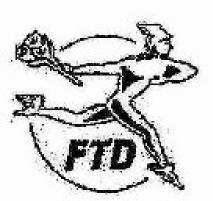 has a trademark on their symbol, a mythological character Mercury, which is the Latin version of the Greek god Hermes. The FTD mark depicts Mercury, or “Mercury Man,” delivering flowers (Registration No. 0821318). They have also trademarked their phone number 1-800-SEND-FTD® (Registration No. 1848732).
has a trademark on their symbol, a mythological character Mercury, which is the Latin version of the Greek god Hermes. The FTD mark depicts Mercury, or “Mercury Man,” delivering flowers (Registration No. 0821318). They have also trademarked their phone number 1-800-SEND-FTD® (Registration No. 1848732).
No one is surprised that candy is one of the most popular Valentine’s Day gifts. 94%¹ of those  celebrating Valentine’s Day will ask for candy in some form. One Valentine’s Day standby is the chocolate heart, such as the one Verlooy Herwig designed in 2001, HEART-SHAPED CHOCOLATE, which is protected by the following design patent: U.S. Patent No. D449,147. Another chocolate-heart option includes the design by Maria Kestekids-Kesdekoglu, CHOCOLATES HAVING A HEART DESIGN in U.S. Patent No. D344,843).
celebrating Valentine’s Day will ask for candy in some form. One Valentine’s Day standby is the chocolate heart, such as the one Verlooy Herwig designed in 2001, HEART-SHAPED CHOCOLATE, which is protected by the following design patent: U.S. Patent No. D449,147. Another chocolate-heart option includes the design by Maria Kestekids-Kesdekoglu, CHOCOLATES HAVING A HEART DESIGN in U.S. Patent No. D344,843).
And no one can forget chomping on Sweethearts® (TM Registration No. 2172266).
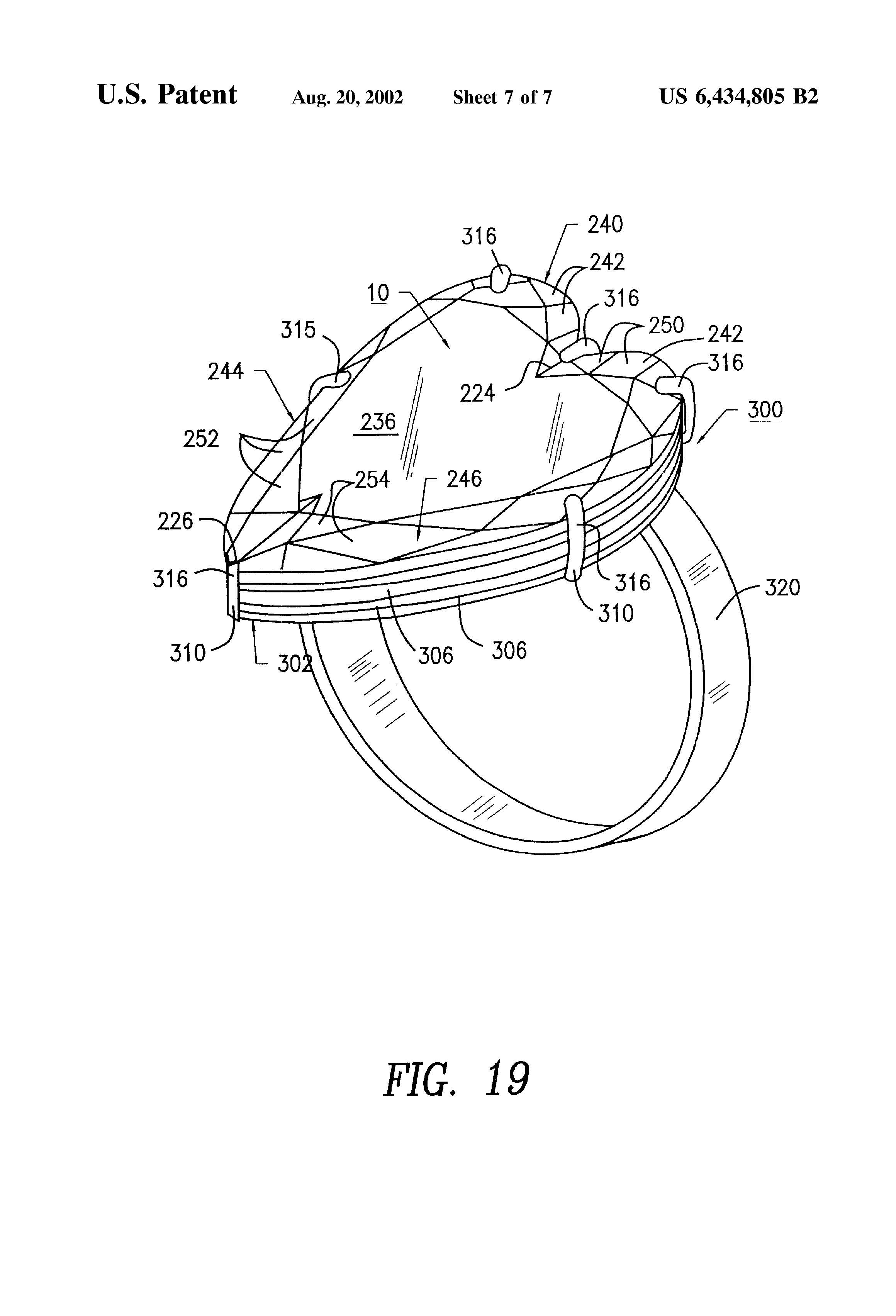 Jewelry is, of course, another option for couples on Valentine’s Day. 18.7%¹ of those purchasing gifts on this Valentine’s Day will choose jewelry for their significant other. Such jewelry options include the TRIPLE HEART JEWLERY WITH DIAMOND OUTLINE, protected via design patent U.S. Patent No. D656,858), which was designed by Pascal Mouaward in 2012. Another option includes the HEART SHAPED DIAMOND CUT HAVING HEARTS AND ARROW PATTERN, covered by the utility patent U.S. Patent No. 8,353,181, which issued in 2013. In 2002, Ami Haimoff patented a new method for creating a heart-shaped diamond, METHOD OF MAKING A HEART-SHAPED DIAMOND, covered by utility patent U.S. Patent No. 6,434,805. This is a process for cutting and placing two pear-shaped diamonds into a side-by-side setting to create a heart-shaped diamond.
Jewelry is, of course, another option for couples on Valentine’s Day. 18.7%¹ of those purchasing gifts on this Valentine’s Day will choose jewelry for their significant other. Such jewelry options include the TRIPLE HEART JEWLERY WITH DIAMOND OUTLINE, protected via design patent U.S. Patent No. D656,858), which was designed by Pascal Mouaward in 2012. Another option includes the HEART SHAPED DIAMOND CUT HAVING HEARTS AND ARROW PATTERN, covered by the utility patent U.S. Patent No. 8,353,181, which issued in 2013. In 2002, Ami Haimoff patented a new method for creating a heart-shaped diamond, METHOD OF MAKING A HEART-SHAPED DIAMOND, covered by utility patent U.S. Patent No. 6,434,805. This is a process for cutting and placing two pear-shaped diamonds into a side-by-side setting to create a heart-shaped diamond.
Of course all of Valentine’s Day-themed products are accompanied by what seems to be an endless number of jewelry-related commercials. Many of the catchy jingles and phrases heard in commercials also have their own have IP protection. For instance, Kay Jewelers’ “Every Kiss Begins with Kay”® is protected via TM Registration No. 2602439. Jared the Galleria of Jewelry protects the slogan “He Went to Jared” with TM Registration No. 4321229. Zales has also trademarked their slogan “Zales the Diamond and Valentine Gift Store” with TM Registration No. 2112448.
For Valentine’s Day we leave you with these parting words from Charles M. Schulz “All you need is love. But a little chocolate now and then doesn’t hurt.”
¹https://wallethub.com/blog/valentines-day-facts/10258/
Patent of the Day: Berry Bush Covering Machine
On this day in 1923 Ernest W. Kummer was granted the patent for BERRY BUSH COVERING MACHINE. U.S. Patent No. 1,444,971.
This invention relates to a machine for covering berry bushes and similar shrubs in order to protect them from the winter frost.
Gardeners and others who live in the part of the country where the winters are severe have found that it is necessary to protect berry bushes, grape vines and similar fruit bearing shrubs and vines from the frost and they have found that the cheapest and most effective way is to lay them down on the ground surface and then cover them with dirt: this entails a large amount of labor and involves considerable expense.
It is the object of this invention to provide a machine that can be drawn by a team of horses and which will gradually bend the bushes over and lay them flat on the ground after which it will automatically cover them with dirt.
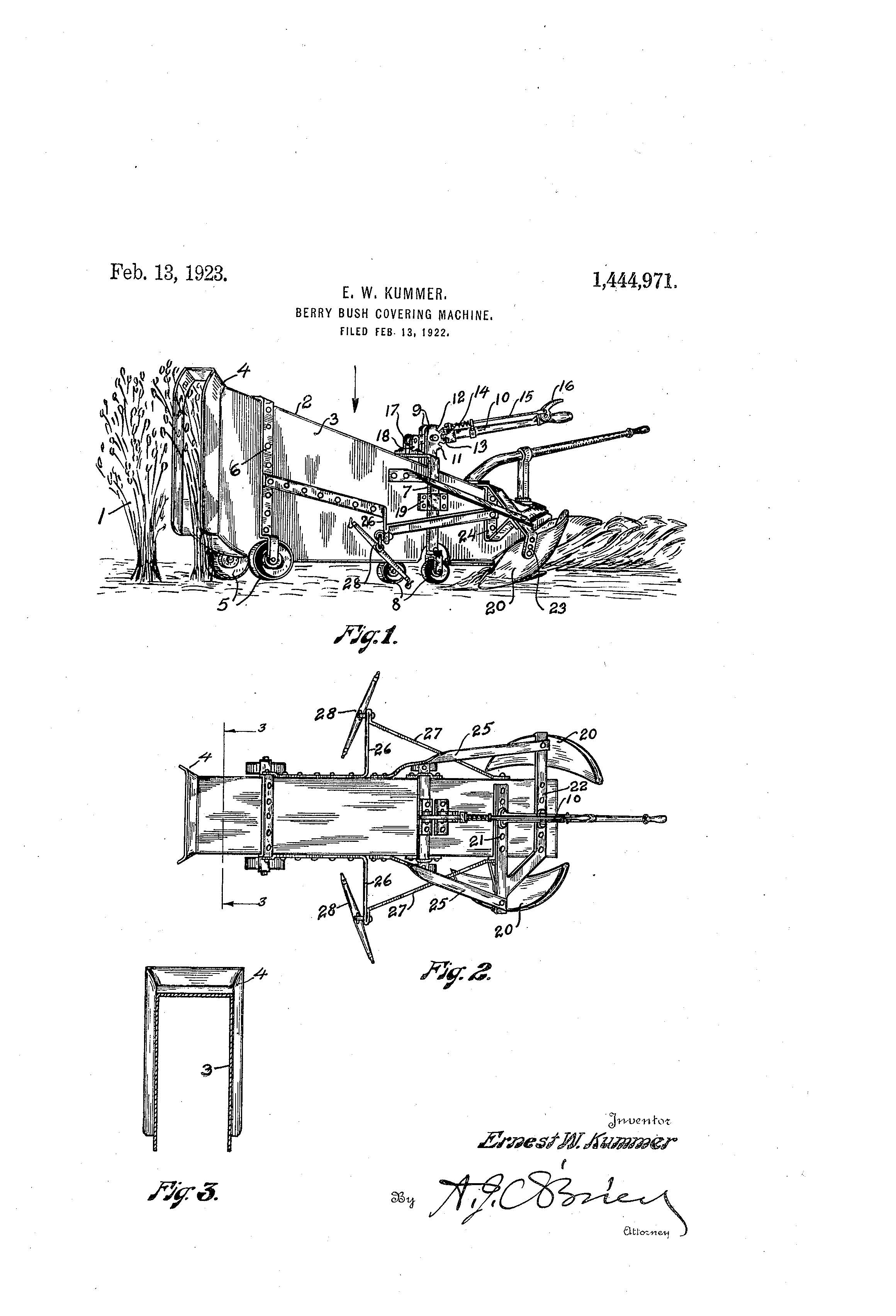
Patent of the Day: Game or Toy (Ouija Board)
On this day in 1891 Elijah J. Bond was granted the patent for TOY OR GAME (Ouija Board). U.S. Patent No. 446,054.
This invention relates to improvements in toys or games, which is designated as an “Ouija or Egyptian luck-board,” and the objects of the invention are to produce a toy or game by which two or more persons can amuse themselves by asking questions of any kind and having them answered by the device used and operated by the touch of the hand, so that the answers are designated by letters on a board.
The invention consists of a board of suitable thickness, having the letters of the alphabet printed, painted, engraved, or affixed upon it in any suitable manner, but flush with the surface, and also the numerals from 1 to 0, inclusive, as well as other configurations, and in conjunction therewith of a peculiarly-shaped table having legs and a pointer, and said table to be operated by the hand when placed upon said board.
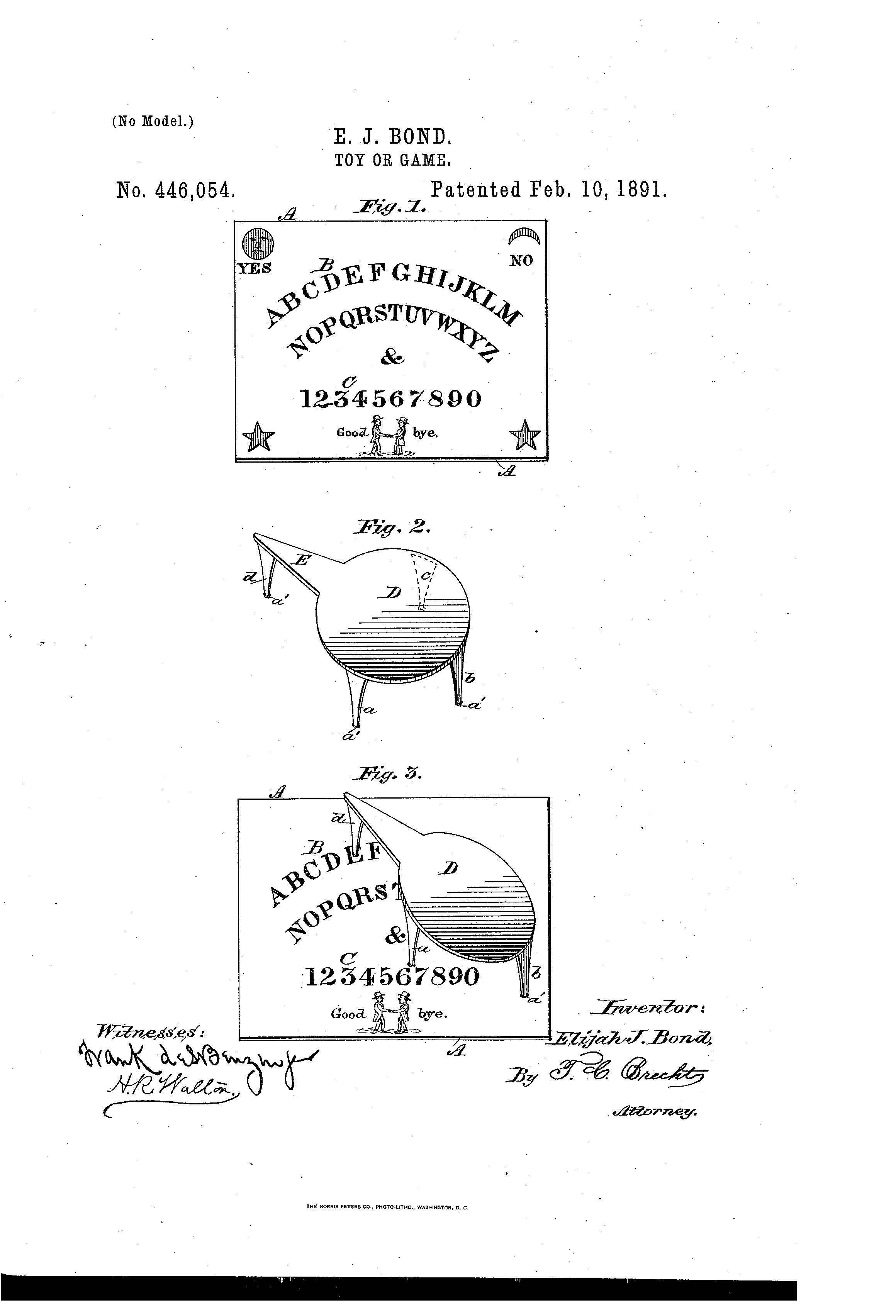
Patent of the Day: Vegetable Cooker
On this day in 1904 John H. Hayes was granted the patent for VEGETABLE COOKER. U.S. Patent No. 751,640.
This invention relates to cooking utensils and the like, and one of the primary objects thereof is to provide a handle which may be normally retracted within the receptacle, but as occasion may demand be extended and swung to one side, so that the open end of the receptacle will be unobstructed.
A further object is to provide a cover for the receptacle which is carried by the handle and mounted so that the movement of the cover will be coincident with the movement of the handle.
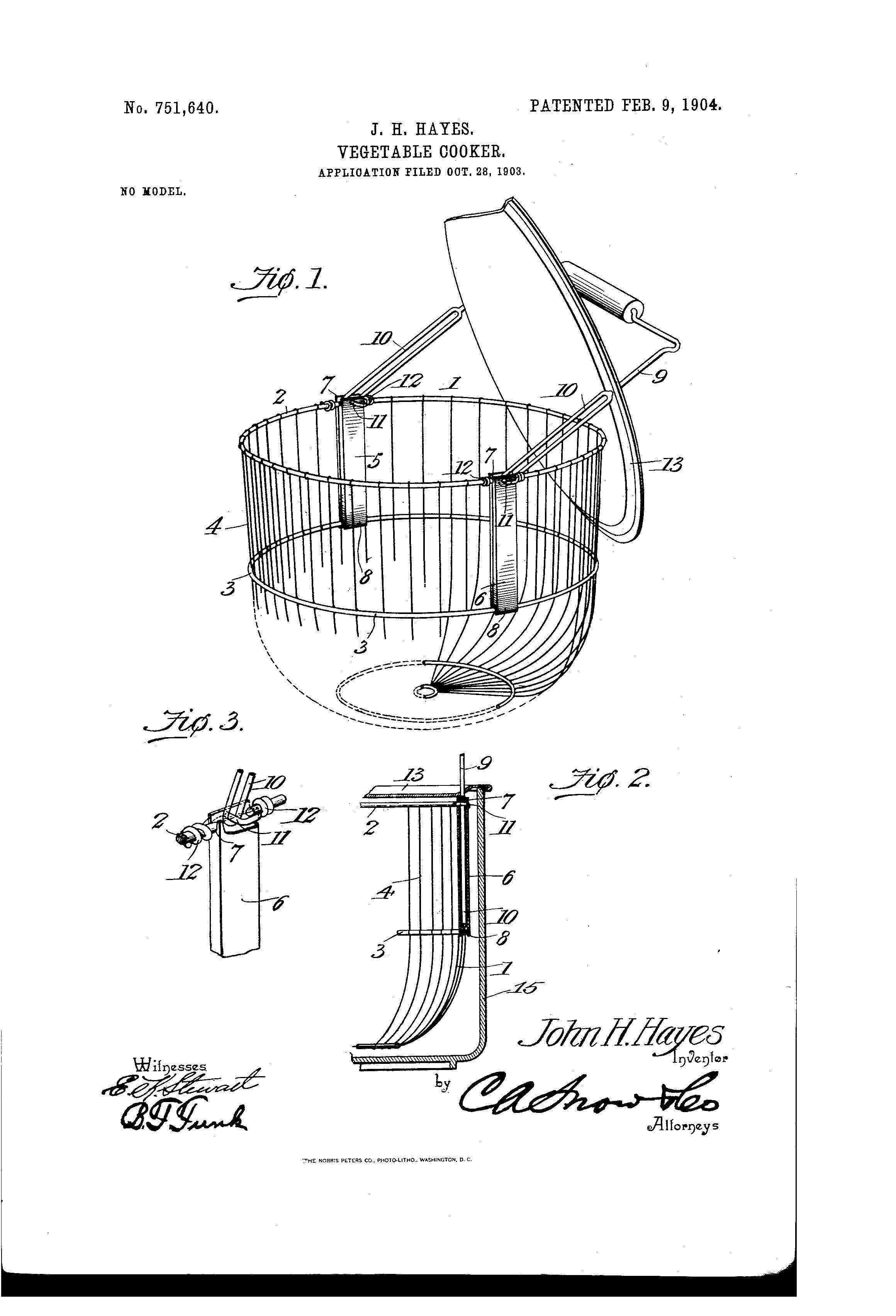
Author Sued for Alleged Copyright Infringement on Classics

Penguin Random House, Simon & Schuster and the trustees for estates of Truman Capote, Jack Kerouac, Ernest Hemingway and Arthur C. Clarke, jointly filed a copyright suit in the New York Federal District Court of Lower Manhattan (Court) against Frederik Colting and Melissa Medina. The suit, filed on January 17th, alleges copyright infringement on four novels, Breakfast at Tiffany's, The Old Man and the Sea, On the Road, and 2001: A Space Odyssey (“Novels”) by the defendants.
According to the complaint, the defendants, doing business as Moppet Books, sought to capitalize on the Novels’ enduring fame and popularity. They reproduced the works as what they advertise as “children’s versions” of the Novels and are offering them for sale on their website (www.kinderguides.com) and third-party retailers such as Barnes & Noble, Amazon, and Books-A-Million.
The complaint alleges the infringing titles are unauthorized derivatives drawing heavily on the plots, themes, events, and characters from each of the four novels. It stated there are many other classic works already in public domain to which the defendants could use to introduce the classics to children. “[T]he Defendants have chosen, instead, to trade upon the current appeal of the Novels, each of which is fully protected by valid and subsisting copyrights in the United States. They have done so purely for their own purposes, agenda and profit, at the expense of plaintiffs, and in complete disregard of copyright law.”
Mentioned in the suit is a previous copyright infringement case involving Colting in this same Court. In June of 2009, the J. D. Salinger estate sued Fredrik Colting for publishing an unauthorized sequel to The Catcher in the Rye. The Court rejected Colting’s author's fair use defense. The case was settled in 2011, where Colting agreed not to publish or distribute his book, 60 Years Later–Coming Through the Rye, in the U.S. or Canada until The Catcher in the Rye enters public domain.
Colting has stated that the books do not infringe on copyrighted works as they “function as study guides as well as entertainment.” The suit states "[q]uick review readily reveals that the infringing works do not even purport to be companion guides or reference books intended for use by readers of the Novels because, as defendants also admit in their marketing materials, the Novels address adult themes and concepts" and “the KinderGuide editions are more closely akin to censored versions of the Novels”.
According to the suit, the defendants’ infringement impacts the reputation of the Novels, their authors, and takes away the exclusive right of the owner “to control how each of the novels is presented to the reading public, in what form, when, and to what audience.” Book reviews given by the New York Times, Forbes, The Guardian, and The Chicago Tribune on the KinderGuides named in the suit have been less than stellar.
The suit is seeking a judgment for the plaintiffs that will ban the defendants from reproducing, publishing, and selling the unauthorized KinderGuides of the four Novels in the United States. They want the judgment to order the defendants to destroy copies in their possession; recall all copies out of their possession, and grant the plaintiffs the profits along with damages and attorneys’ fees.

